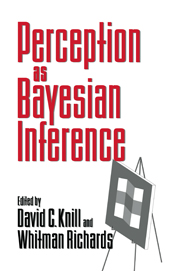0 - Introduction
Published online by Cambridge University Press: 05 March 2012
Summary
Overview
Bayesian approaches have enjoyed a great deal of recent success in their application to problems in computer vision (Grenander, 1976-1981; Bolle & Cooper, 1984; Geman & Geman, 1984; Marroquin et al., 1985; Szeliski, 1989; Clark & Yuille, 1990; Yuille & Clark, 1993; Madarasmi et al., 1993). This success has led to an emerging interest in applying Bayesian methods to modeling human visual perception (Bennett et al., 1989; Kersten, 1990; Knill & Kersten, 1991; Richards et al., 1993). The chapters in this book represent to a large extent the fruits of this interest: a number of new theoretical frameworks for studying perception and some interesting new models of specific perceptual phenomena, all founded, to varying degrees, on Bayesian ideas. As an introduction to the book, we present an overview of the philosophy and fundamental concepts which form the foundation of Bayesian theory as it applies to human visual perception. The goal of the chapter is two-fold: first, it serves as a tutorial to the basics of the Bayesian approach to readers who are unfamiliar with it, and second, to characterize the type of theory of perception the approach is meant to provide. The latter topic, by its meta-theoretic nature, is necessarily subjective. This introduction represents the views of the authors in this regard, not necessarily those held by other contributors to the book.
First, we introduce the Bayesian framework as a general formalism for specifying the information in images which allows an observer to perceive the world.
- Type
- Chapter
- Information
- Perception as Bayesian Inference , pp. 1 - 22Publisher: Cambridge University PressPrint publication year: 1996
- 33
- Cited by

